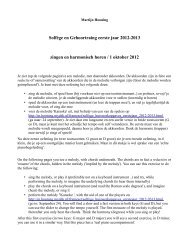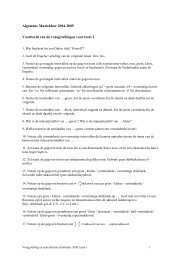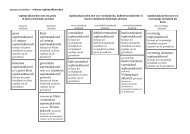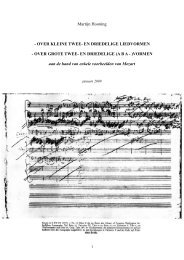Martijn Hooning SOME REMARKS ON SONATA FORM with an ...
Martijn Hooning SOME REMARKS ON SONATA FORM with an ...
Martijn Hooning SOME REMARKS ON SONATA FORM with an ...
You also want an ePaper? Increase the reach of your titles
YUMPU automatically turns print PDFs into web optimized ePapers that Google loves.
modulating. We could then speak of <strong>an</strong> 'introduction'.<br />
We could call the modulating part of a development the 'central<br />
section'. In this part we will find mainly the processing of musical<br />
material of the exposition.<br />
The development section normally ends on a domin<strong>an</strong>t pedal<br />
point: V of the home key is in the bass const<strong>an</strong>tly, <strong>an</strong>d at the same<br />
time on top of that bass other harmonies might occur. Sometimes a<br />
pedal point is less literal, when V is encircled more then kept in<br />
the bass all the time. And in some pieces the pedal point is on a<br />
'wrong domin<strong>an</strong>t', so the development is ending in the 'wrong key'.<br />
The 'mistake' then has to be 'repaired' in the last moment, just<br />
before the start of the recapitulation. 2<br />
RECAPITULATI<strong>ON</strong><br />
first theme (or: first group)<br />
Repeat of the first group of the exposition. Sometimes some<br />
ch<strong>an</strong>ges are made (like: extension, use of a different key, ch<strong>an</strong>ge<br />
of the motivic content etc.). The first group will always stay<br />
recognizable though.<br />
Sometimes the recapitulation is starting in a different key; 3 to a<br />
certain extent we could think this different key as a 'wrong key';<br />
often a modulation to the 'right key' is taking place further on in<br />
the first group.<br />
tr<strong>an</strong>sition (or: tr<strong>an</strong>sition section)<br />
In principle it is not necessary to write a modulation in this<br />
section, as the first <strong>an</strong>d second theme are in the same key now.<br />
Very often there is a modulation though (or: a modulation is<br />
suggested). The difference <strong>with</strong> the exposition: this time the<br />
modulation is starting <strong>an</strong>d ending in the same key.<br />
See also the remarks about the tr<strong>an</strong>sition in the exposition..<br />
In early Classical sonatas, when there is no modulation in the<br />
tr<strong>an</strong>sition in the exposition, this turns out to be quite 'h<strong>an</strong>dy' in the<br />
recapitulation: when there is a half cadence at the end of the<br />
C: V c: V c: V<br />
C<br />
mostly<br />
modulating<br />
section<br />
(from ca.<br />
1780) -<br />
though<br />
the keys<br />
in the<br />
beginning<br />
<strong>an</strong>d at the<br />
c<br />
mostly<br />
modulating<br />
section<br />
(from ca.<br />
1780) -<br />
though<br />
the keys<br />
in the<br />
beginnin<br />
g <strong>an</strong>d at<br />
c<br />
mostly<br />
modulating<br />
section<br />
(from ca.<br />
1780) -<br />
though<br />
the keys<br />
in the<br />
beginnin<br />
g <strong>an</strong>d at<br />
2 Well-liked by composers is above all the domin<strong>an</strong>t of the relative minor key, when the piece is in a major key. See<br />
for example: Beethoven: First Symphony, first movement; the piece is in C major, the pedal point at the end of the<br />
development is on E, V of a minor, the relative minor key. In Beethoven's sonata in F major Op. 10,2 things are<br />
even more confusing: the development section is ending on V of d minor (relative minor key); then the<br />
recapitulation is beginning in the 'wrong key' D major! (only later in the recapitulation of the first theme the key is<br />
ch<strong>an</strong>ging to F major).<br />
3 See footnote 1 (Beethoven's sonata in F major)<br />
6






